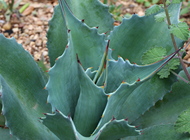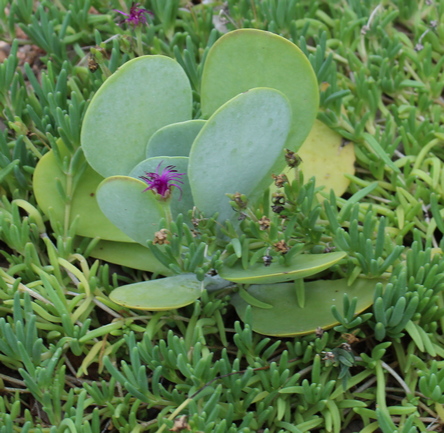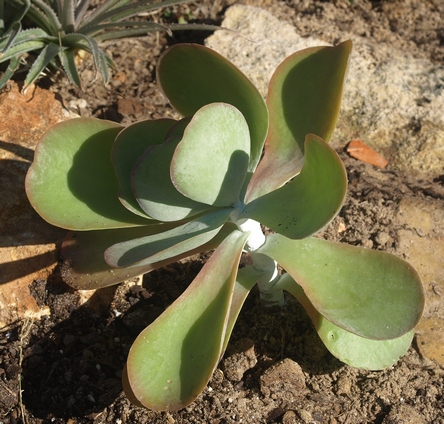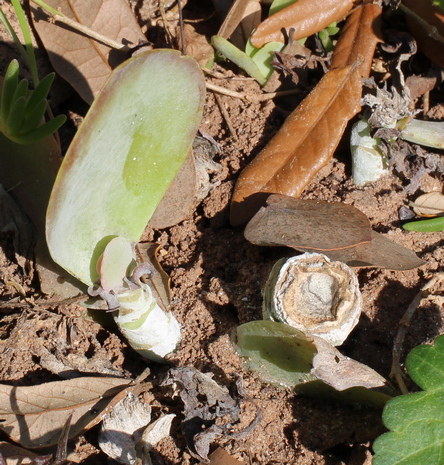 |
Kalanchoe tetraphylla |
 |

| | Viewing from above explains the four-leaf name |
| 
| | July: rising up out of a sea of ice plant in our rock garden |
|

| | Rosy color after a light freeze (Nov 2018) |
| Synonym(s) |
Kalanchoe thyrsiflora |
| Common name |
paddle plant, flapjacks |
| Family |
crassulaceae |
| Life cycle |
perennial (Z10-12)   |
| Flowers |
yellow |
| Size |
12-30" |
| Light |
sun-part shade |
| Cultural notes |
well drained soil; drought tolerant |
South African native with large paddle-shaped succulent leaves that color up reddish pink along the rims when grown in full sun. The leaves are arranged in alternating pairs, making for a boxy enclosure as shown in photo above. Flowers on spikes well above the leaves after several years. After flowering, the mother plant dies, but the patch typically lives on by the offsets that have been produced in the meantime. We saw a nice patch of this plant growing at Peckerwood Garden and were happy to see a few smaller plants up for grabs in the sale area. Of course I had to enlarge the rock garden upon returning home to accommodate it, but such are the challenges of the compulsive plant collector.
I was told that at Peckerwood, this is one of the few plants that receives supplemental freeze protection during the coldest nights, so I tried to cover it during the several severe (for Houston) freezes in January 2018 – but one whopper freeze that went on for more than 24 hours was too much, and turned the entire plant, including what I could see of its base, to mush. Ever hopeful, I left the stub in place, and was eventually rewarded, in early April: two small leaves marking the return of the tender succulent. Hopefully, our plant will become more firmly established during its first full season in our garden, so that it will be ever better equipped to resist any future freezes – because I'm not so good at running out with blankets every time a freeze threatens! By the end of the year, it still wasn't nearly as large as the plant we purchased, but full of potential (and a rosy glow). This time, the winter was mild, and our specimen did not sustain significant damage. The next winter continued this pattern, and lulled me into a false sense of security – until the forecasts for the big freeze of February 2021 became ever more ominous. Attempting to protect the plant that had finally reached close to its original proportions, I covered a large part of the rock garden with a heavy blanket, held down by strategically placed stones. Although the blanket could only do so much, I'm sure it helped prevent the complete demise of the plant: once again, a tiny portion of it survived, hoping for a longer stretch of freeze-free years this time. Alas, I got complacent for the next freeze, and failed to protect our paddle plants – they perished that time.
|

| | Still rosy in March, now contrasting with ice plant encroaching on its territory |
| 
| | Newly planted, two months before the 2018 freeze |
|

| | Return from the deathly freeze (April 2018) |
| 
| | Whacked back once again, by the Feb '21 freeze, just barely surviving |
|
This plant used to grow in our garden, but it slipped away... About my plant portraits
PlantLinks to other web pages about Kalanchoe tetraphylla
I welcome comments about my web pages; feel free to use the form below to
leave feedback about this particular page. For the benefit of other visitors
to these pages, I will list any relevant comments you leave, and if
appropriate, I will update my page to correct mis-information. Faced with an
ever-increasing onslaught of spam, I'm forced to discard any comments including
html markups. Please submit your comment as plain text. If you have a
comment about the website as a whole, please leave it in my
guestbook. If you
have a question that needs a personal response, please
e-mail me.
Last modified:
February 15, 2025
Contact me
|










